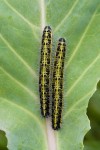There are two species on campus which drive the gardener mad! The Large White (Pieris brassicae) and the Small White (Pieris rapae). These species feed on the Brassicales order, especially the Brassicaceae family, the Cabbages and Mustards, to most of us. Both butterfly species are widespread throughout the UK countryside, including Orkney and Shetland and do migrate from the continent to the UK, both from the south and the east.
The Large White adults, have a pale lime green-pale yellow underside to the hindwing and parts of the forewing. The females also have two black dots on the underside of the forewing. These dots are not present on the males, see image 1. The topside of the wings is white, with 2 black dots on each forewing of the females (none on the males) with both males and females having a large black crescent shape tip to the forewings, see image 2. Their wingspan is approximately 65mm.
- Image 1 Large White Female but shows the typical pale yellow underwings © UK Butterflies Peter Eeles
- Image 2 Male and Female Large White showing upperside of wings © UK butterflies Vince Massimo
- Image 3 Small White showing the typical colour of the underwing © UK Butterflies Peter Eeles
- Image 4 Small White Male showing upperwing © UK Butterflies Vince Massimo
- Image 5 Small White Female showing upper wing surface © UK Butterflies Vince Massimo
- Image 6 Large White eggs © UK Butterflies Peter Eeles
- Image 7 Large White Caterpillars © UK Butterflies Peter Eeles
- Image 8 Small White caterpillar © UK Butterflies Peter Eeles
The Small White adults are very much the same colour as large whites, from beneath a pale lime green-pale yellow, however small whites are about ¾ of the size see image 3. The females also have two black dots on the underside of each forewing whereas males only have one. The topside of the wings in both males and females is white and females usually have two small black dots on each forewing with males only having one. The wing tips of both males and females are grey to black, and this covers a much smaller area that the large white, see image 4 and 5, and forms a dark triangle. Their wingspan is approximately 50mm.
Both species are multivoltine, and can have 2 generations a year, with three possible in good years. The Large White lays clusters of unmistakable, conical, bright yellow, ribbed, eggs on the upper and lower sides of leaves, whereas the Small White lays single, conical pale, lime-green eggs, on the underside of the leaves, see image 6. The eggs of both hatch and the larvae feed on the leaves of the plant, often going for the central heart. With the Large White caterpillar being protected by irritant and poisonous mustard oils, they concentrate from their food plants, hence the caterpillar’s hairy and black and yellow colouration, see image 7. Caterpillars of the Small White are pale green and downy, see image 8. The caterpillars then pupate and can produce adults within 2 weeks for the summer brood (second generation). However, after the summer brood, either a third generation will be produced if conditions allow, or the pupae will stay dormant until the following spring. Each caterpillar has 5 instars and 4 moults.
Fact: The Small White is thought to travel over 100 miles in a lifetime. Such colonising ability was shown with their introduction to Australia, where in 3 years the species had covered 1850 miles.
Sites you may wish to visit are:
http://www.butterfly-conservation.org/
http://www.ukbutterflies.co.uk/index.php
http://www.hantsmoths.org.uk/index.htm
We thank photographers from UK Butterflies for permission to use their images. Individual credits are given with each image.
Please record any sighting on campus including the date, in the comments section below, for assessment by subsequent authors.








